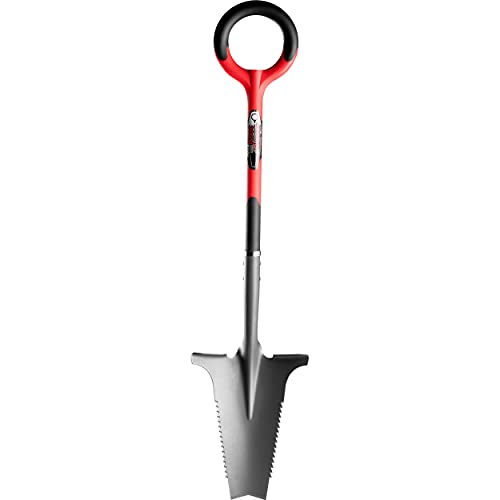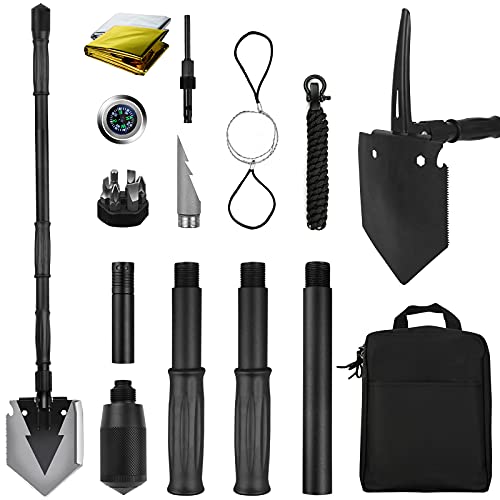




A scoop shovel, also known as a grain scoop, is a tool designed for moving materials such as grain, dirt, snow, or other loose substances. It typically consists of a curved blade or bucket attached to a long handle. This versatile tool is commonly used in various industries, including agriculture, construction, landscaping, and gardening.
The curved blade of a scoop shovel allows for efficient scooping and lifting of materials. It is often made of durable materials such as steel or aluminum to withstand heavy use. The size and shape of the blade can vary, depending on the intended use. Some scoop shovels have a flat bottom, while others have curved edges, allowing for better containment of materials.
In agriculture, scoop shovels are commonly used for tasks such as moving grain, feed, or other agricultural products. They are also essential for cleaning out animal stalls and barns. In construction, scoop shovels are used for moving and spreading loose materials like sand, gravel, or concrete. Landscapers use scoop shovels for tasks such as spreading mulch, topsoil, or gravel. They are also useful for clearing away snow during winter months.
Overall, scoop shovels are a handy tool that helps simplify various manual labor tasks. Whether you need to move heavy materials, clean out a space, or clear away debris, a scoop shovel is a reliable and practical tool to have in your arsenal.
Definition and purpose of scoop shovels
A scoop shovel, also known as a scooper or a grain shovel, is a specialized type of shovel designed for moving loose materials, such as soil, sand, gravel, snow, or agricultural commodities.
The scoop shovel features a wide flat blade with a deep bowl or scoop shape, allowing it to carry a larger volume of material with each scoop. The blade is typically made of durable materials like steel or aluminum to withstand heavy use and resist bending or breaking. The handle is usually long and sturdy, providing leverage and control during lifting and throwing.
Scoop shovels are commonly used in various industries and applications. In construction and landscaping, they are used for digging and moving soil, gravel, and other materials. In agriculture, they are used to handle and transport grains, seeds, and other agricultural commodities.
They are also widely used for snow removal, as the large blade can quickly scoop up and clear snow from driveways, sidewalks, and paths. Additionally, scoop shovels can be used for cleaning debris, such as leaves or trash, from outdoor surfaces.
| Key features of scoop shovels: |
|---|
| Wide flat blade with a deep scoop shape |
| Durable materials like steel or aluminum |
| Long and sturdy handle for leverage |
In summary, scoop shovels are versatile tools designed for efficient and effective material handling. Whether it’s moving soil, snow, gravel, or agricultural products, the scoop shovel’s design and features make it a valuable tool in various industries and applications.
Types of scoop shovels
Scoop shovels, also known as grain scoops or grain shovels, are versatile tools used in a variety of applications. They are commonly used in agriculture, construction, gardening, and landscaping to move loose materials such as grain, sand, gravel, and mulch. There are different types of scoop shovels available, each designed for specific purposes and tasks.
1. Round point scoop shovel
The round point scoop shovel features a rounded blade with a pointed tip. This type of shovel is ideal for digging and transferring loose materials such as soil and mulch. The pointed tip allows for easier penetration into the ground, making it easier to scoop up materials. It is commonly used in gardening and landscaping.
2. Square point scoop shovel
The square point scoop shovel has a flat, squared-off blade. It is designed for digging and lifting heavy materials such as gravel, sand, and rocks. The flat blade provides better stability and leverage when lifting heavy loads. It is commonly used in construction and general-purpose applications.
3. Snow scoop shovel
The snow scoop shovel, also known as a snow pusher, is specifically designed for snow removal. It features a wide, curved blade that allows for efficient pushing and lifting of snow. The curved shape helps prevent snow from spilling over the sides. It is commonly used in areas with heavy snowfall.
4. Grain scoop shovel
The grain scoop shovel is specifically designed for handling grain, but it can also be used for other loose materials. It features a deep, wide blade with high sides to prevent spillage. The design allows for easy scooping and transferring of grain without excessive spills. It is commonly used in agriculture and grain handling.
These are just a few examples of the different types of scoop shovels available. The right type of shovel for a specific task depends on the material being moved and the intended use. Choosing the appropriate shovel can make a significant difference in terms of efficiency and ease of use.
Materials used for scoop shovel construction
A scoop shovel is a versatile tool commonly used in gardening, construction, and farming. It is typically made of sturdy materials to withstand heavy use and provide durability. Here are some of the common materials used in scoop shovel construction:
| Material | Description |
| Steel | Steel is one of the most common materials used for scoop shovel construction. It is known for its strength and ability to withstand heavy loads. Steel scoop shovels are typically rust-resistant and can handle tough digging tasks. |
| Aluminum | Aluminum scoop shovels are lightweight and easy to handle. They are often used in gardening and landscaping tasks where less strength is required. Aluminum is also resistant to rust and corrosion, making it a popular choice for scoop shovel construction. |
| Fiberglass | Fiberglass scoop shovels are lightweight and durable. They are commonly used in construction and farming tasks where a strong yet lightweight tool is needed. Fiberglass is resistant to rust, corrosion, and weathering, making it suitable for outdoor use. |
| Wood | Wooden scoop shovels are less common but are still used in some traditional applications. They are typically made from hardwoods like ash or hickory, known for their strength and resistance to breaking. Wooden scoop shovels require regular maintenance to prevent splintering and cracking. |
| Plastic | Plastic scoop shovels are lightweight and affordable. They are often used in gardening and light-duty tasks. However, they may not be as durable as other materials and can be prone to breaking under heavy loads. |
The choice of material for a scoop shovel depends on the intended use and personal preference. It is important to select a scoop shovel made from high-quality materials to ensure longevity and optimal performance.
Common uses for scoop shovels
Scoop shovels, also known as grain scoops or coal shovels, are versatile tools that are commonly used in a variety of industries. Their unique design and construction make them ideal for certain tasks. Here are some common uses for scoop shovels:
| Industry | Use |
|---|---|
| Agriculture | Scoop shovels are frequently used in agricultural settings to handle bulk materials such as grains, animal feed, and fertilizers. They are particularly useful for loading and unloading these materials onto trailers or into storage bins. |
| Construction | In the construction industry, scoop shovels are often used for digging and moving loose materials like gravel, sand, and dirt. They are commonly employed in landscaping projects, excavation work, and foundation construction. |
| Gardening | Scoop shovels are an essential tool for gardeners and landscapers. They can be used to transport soil, mulch, and compost, as well as for digging holes for planting trees, shrubs, and flowers. |
| Waste management | Scoop shovels play a crucial role in waste management operations. They are used to collect and transfer solid waste, such as garbage or debris, into containers or trucks for disposal. |
| Snow removal | During winter months, scoop shovels are commonly employed for snow removal purposes. They are used to clear driveways, sidewalks, and parking lots by scooping up and removing accumulated snow. |
Overall, scoop shovels are highly versatile tools that can be found in various industries and are essential for tasks that involve moving bulk materials or clearing debris. Their sturdy construction and wide, deep blades make them a reliable choice for a range of applications.
Proper technique for using a scoop shovel
Using a scoop shovel correctly is essential for efficient and safe work. Here are some tips on how to use a scoop shovel properly:
1. Starting position:
Stand with your feet shoulder-width apart, ensuring a stable base. Hold the scoop handle with both hands, one hand near the top and the other closer to the blade.
2. Lifting technique:
Bend your knees and keep your back straight. Use your leg muscles to lift the shovel and the load, rather than relying on your back. Engage your core muscles to provide stability while lifting.
3. Scooping:
Lower the shovel blade to the ground, keeping it parallel to the surface. Use your leg muscles to lift the load, not your back. The blade should be completely beneath the load before attempting to lift it.
4. Carrying:
Keep your back straight and avoid twisting your body while carrying the load. Hold the handle firmly with both hands and walk slowly, maintaining your balance.
5. Dumping:
When dumping the load, use your leg muscles to lower the shovel while keeping your back straight. Tilt the shovel forward to release the contents, making sure to clear the area.
6. Safety precautions:
Always wear appropriate footwear and gloves to protect your hands. Take breaks when needed and stay hydrated, especially during strenuous work. If the load is too heavy, ask for assistance or use a smaller shovel.
By following these proper techniques, you can minimize the risk of injury and ensure efficient and effective use of a scoop shovel.
Tips for maintaining and storing scoop shovels
Maintaining and storing your scoop shovel properly is essential to ensure its longevity and functionality. Here are some tips to help you keep your scoop shovel in good condition:
Clean after use
After using your scoop shovel, it’s important to clean off any debris or dirt that may have accumulated on the blade and handle. Use a brush or hose to remove any excess material and let it dry before storing.
Check for damage
Regularly inspect your scoop shovel for any signs of wear or damage. Look for bent or cracked handles, loose or missing screws, and worn-out blades. If you notice any issues, repair or replace the parts as necessary to avoid further damage or injury.
Store properly
When storing your scoop shovel, make sure to keep it in a dry and secure place. Hanging it on a wall or storing it in a shed or garage are good options. Avoid leaving it out in the elements, as exposure to moisture and extreme temperatures can cause rust and deterioration.
Apply lubrication
To prevent rust and ensure smooth operation, it’s recommended to apply a thin layer of lubricant on the blade and moving parts of your scoop shovel. This will help reduce friction and make shoveling easier.
Sharpen the blade
If your scoop shovel’s blade becomes dull over time, sharpen it using a file or grinder. A sharp blade will make digging and moving material more efficient and less strenuous.
Follow manufacturer’s instructions
Lastly, always refer to the manufacturer’s instructions for specific maintenance and storage guidelines for your scoop shovel. Different models may have unique requirements, so it’s best to follow their recommendations to ensure optimal performance and durability.






